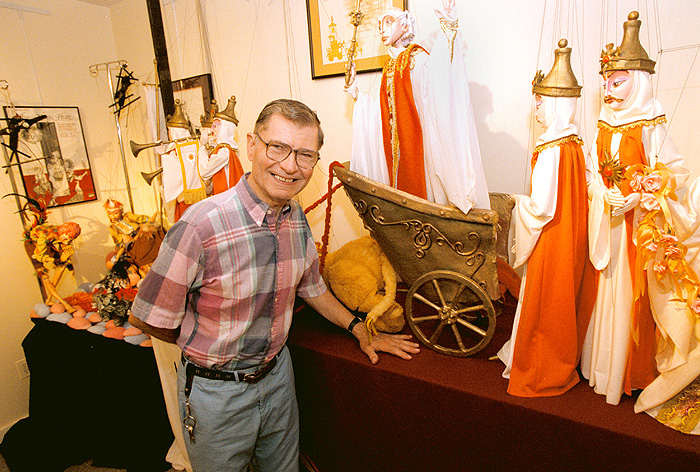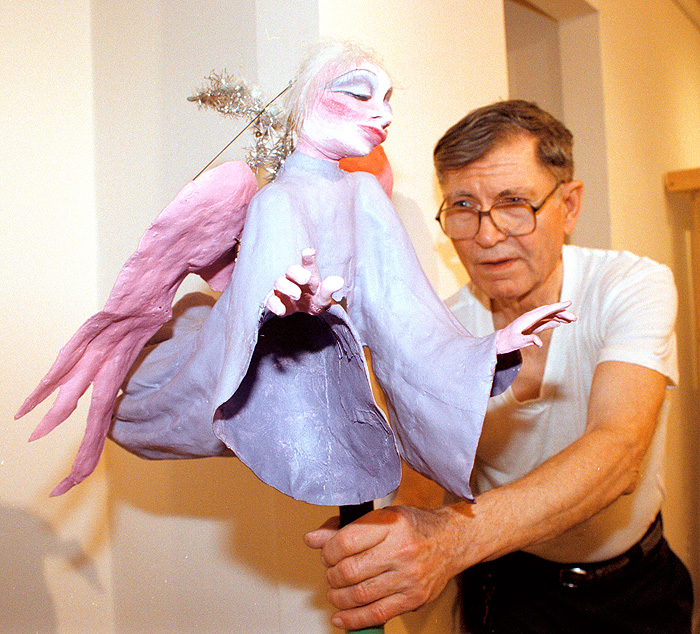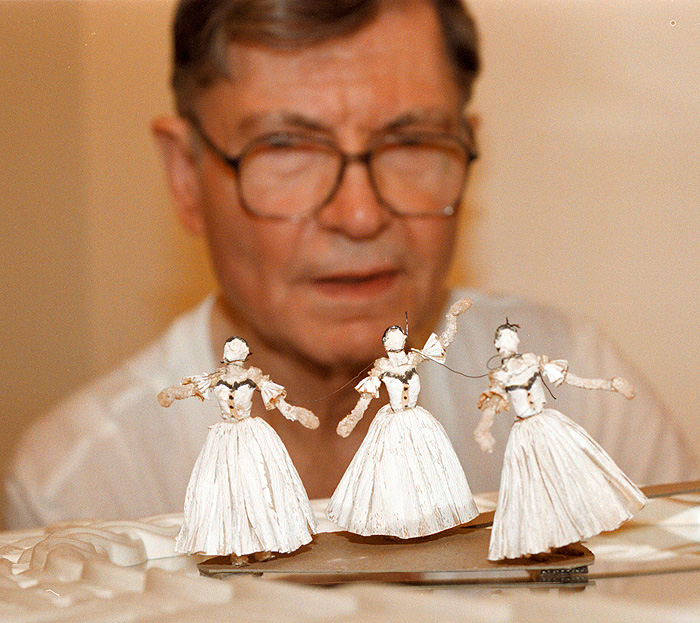
Frank Willard Ballard, internationally renowned puppeteer, died on June 4 after a decades-long battle with Parkinson’s Disease. He was 80.
Born in Alton, Ill., he discovered a fascination for his craft at age five when his Aunt Margaret took him to a puppet show. That experience started a life-long passion with the theater and the art of puppetry that led to international acclaim during his three decades at the University of Connecticut from 1956 to 1989.
As a youth, Ballard performed his first puppet show The Three Little Pigs for his stuffed penguin Pal Alfred and any relative who happened to wander into the room. Throughout school and college, he maintained a 10-person company, which included his future wife, Adah Ruth Smalley. Along the way, his Aunt Margaret helped build puppets, his father Glen built stages, and his mother Alice drove him to performances.
Ballard received his BA from Alton’s Shurtleff College and a master’s degree from the University of Illinois. He married Adah Ruth Smalley in 1953 and they spent the next three years at the University of Iowa, where he served as a designer of educational television shows.
In 1956, Ballard was hired as the set designer and technical director of the new Harriet S. Jorgensen Theatre at the University of Connecticut. He was appointed to the faculty of the Department of Speech and Drama. Six years later, the Drama, Art, and Music Departments merged to form the School of Fine Arts.

Ballard founded UConn’s puppetry program, which soon became the only program in the United States to offer graduate and undergraduate degrees in puppetry. Ballard directed and designed countless puppetry productions at UConn, beginning with a 1961 performance of Macbeth for television.
More than a dozen of Ballard’s full-scale UConn puppet productions followed on the Jorgensen stage, incorporating a wide variety of art forms from marionettes to rod puppets, shadow puppets, hand puppets, and masks. His final UConn production was H.M.S. Pinafore in 1989, which was one of three Ballard productions awarded a Citation of Excellence in the Art of Puppetry from L’Union International de la Marionette (UNIMA)-U.S.A. He also received that honor for The Golden Cockerel (1977) and The Magic Flute (1986). Another one of his productions, Wagner’s Ring of the Nibelung, was performed at the Kennedy Center in Washington, D.C., in 1980.
During his UConn tenure, Ballard produced, designed, and directed 100 operas and musicals for puppet theater, created more than 1,500 individual puppets, and was the founder and namesake of the Ballard Institute and Museum of Puppetry (BIMP).
Ballard was the American representative to the 40th anniversary celebration of the international puppetry organization UNIMA in Prague, Czechoslovakia in 1963, beginning two decades of serving his profession in countless roles nationally and internationally. He served Puppeteers of America in many roles, including president from 1971 to 1974; represented the U.S. at the UNIMA events in France, the Soviet Union, the U.K., and Belgium; and was president of UNIMA-U.S.A. from 1980 to 1982. In 1984, UNIMA awarded Ballard its highest recognition.
Ballard addressed the United Nations General Assembly in 1972 on the cultural aspects of puppetry in the United States. In 1976, he was named as a Notable American of the Bicentennial Era by the American Bicentennial Institute, and received the President’s Award from the Puppeteers of America, that organization’s highest award. He was named to Who’s Who in the East, Who’s Who in America, and Who’s Who in the Theatre.
Over the years, Ballard served as a puppetry consultant for numerous organizations, including the Smithsonian Institution (1978-79). He was named Connecticut Professor of the Year in 1988. The author of numerous articles, Ballard also co-wrote the book Directing the Puppet Theatre (1989) with Carol Fijan, and wrote the puppetry entry for the Encyclopedia Britannica in 2000.

Ballard’s puppetry creations have been exhibited all over the United States and abroad, including Czechoslovakia, Argentina, Canada, France, and the USSR. Ballard was honored by the Connecticut Commission on the Arts, received the Life Achievement Citation from the New England Theatre Conference and, upon his retirement in 1989, received a letter from President George H.W. Bush saluting him for his contribution to the arts. In 1997, he was given a Lifetime Achievement Award by the UConn School of Fine Arts.
In addition to the stage, Ballard had a passion for classical music and opera. His late English bulldog Winston was dear to his heart, and one of the great joys in his life was his four grandchildren. His generous and caring personality earned him the moniker “second father” to numerous students he nurtured and befriended through the years, guiding them into a wide variety of the arts, including their own puppetry companies, work for stage and screen, and employment with organizations such as The Muppets.
Some of Ballard’s puppets currently are on display in the University of Connecticut School of Fine Arts Music and Drama Library and the Mansfield Community Center in Storrs. A larger retrospective of Ballard’s work in puppetry will be featured by the Institute and Museum as part of its 2011 season.
Ballard was predeceased by his wife of 56 years, Adah Ruth, who died in March. He is survived by his brother Irwin, his sister Alice Casner, and his sons, David and his wife Robin, and Michael and his wife Beverly.
Memorial contributions should be made out and mailed to the University of Connecticut Foundation, 2390 Alumni Drive, U-3206, Storrs, CT 06269. Please indicate the Frank and Adah Ruth Ballard Memorial Fund (#22736) on the memo line of the check.
There will be a memorial service on Saturday, July 10, at 10 a.m. in the Storrs Congregational Church. For an online memorial guestbook, please visit the Potter Funeral Home website.


